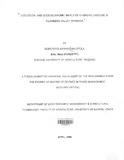| dc.description.abstract | The study was conducted in Malinyi ward, Ulanga district in Tanzania. The aim of the
study was to determine the ecological and socio-economic effects of changing land use
patterns due to pastoral migration in the area. The emphasis was on vegetation changes,
soil characteristics, and local people's perception about changes in natural resource
utilization patterns and interaction between livestock keepers and cultivators in area that
may attribute to such migration and subsequent alteration in land use types. The study
area was mainly an alluvial floodplain, receiving long term average rainfall of 1000mm per
annum. The predominant land uses were cultivation, grazing, and the combination of the
two (agro-pastoralist). The study methods employed were fieldwork analysis for vegetation
such as density, cover, production, species composition and plant recruitment and soil
characteristics include pH, moisture content, organic carbon, organic matter, total
nitrogen, bulk density, and texture. Interviews were conducted using structured
questionnaires; both formal and informal discussions were also held with key informants
including household heads, elders, government, and development agencies to get socioeconomic
information in the study area.
The results of the field vegetation analysis showed greater number of woody species
recruitment, density, and crown cover in agro-pastoral area than the pastoral,
cultivators and reserve areas. The comparison of density for three selected woody
species showed significant differences (P < 0.05) for Bauhinia thonningii and
Combretum tertifolium and no significant difference for Afrormonsia angolensis among
four land use types. For woody vegetation crown cover of selected species showed
significant difference (P < 0.05) for Combretum tertifolium and no significant difference
for Afrormonsia angolensis and Bauhinia thonningii between land use types.
Herbaceous vegetation biomass production and basal cover were higher in reserve
area than pastoral, agro-pastoral·, and cultivators areas. When compared between land
use types the basal cover of selected grass species showed significant differences (P <
0.01) for Hyperrehnia dissoluta and Panicum maximum, while there was no significant
difference for Themeda triandra. All three-forb species (Bidens pilosa, Watheria indica
and Flaveria bidentis) basal cover showed no significance differences between land
use types. The soil characteristic of the study are(l.hadhigher moisture, organic matter,
organic carbon, nitrogen content, and low bulk density in reserve area than agropastoral,
pastoral, and cultivator area. The socio-economic information showed that
there was increasing demand on land resources due to population increase and
changing land use patterns. The cultivators have been forced to hire farmland, the
fallowing period had been shortened and existence of conflicts between the cultivators
and livestock keepers. This resulted in reduction of vegetation cover, wildlife numbers,
low water level of Kilombero River and its tributaries. There are also mutual benefits
between the three communities, the Ndamba cultivators used get livestock products
and crop market, the Sukuma agro-pastoralists labour and market for crop and
livestock products and the Maasai pastoralists market for livestock products and food,
the major problem between them is livestock damage to farmer's crops.
The study recommended demarcation of grazing land from farming land, technological
support to improve soil and water conservation, crop and livestock production and
development of proper marketing systems for crop and livestock products. Future
research should focus on integration of crop and livestock production, protection and
management of preferred plant species in the study area. | en |

